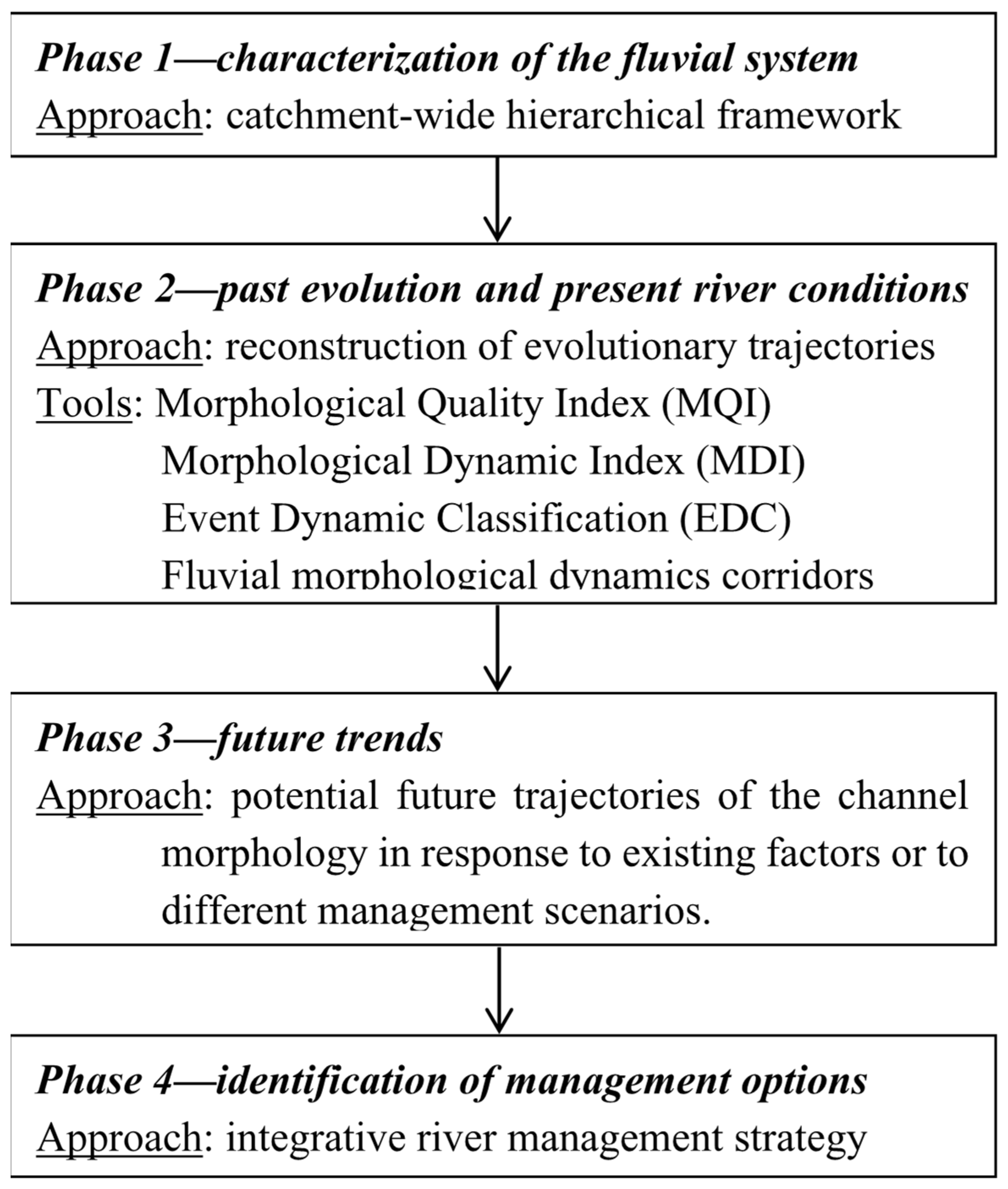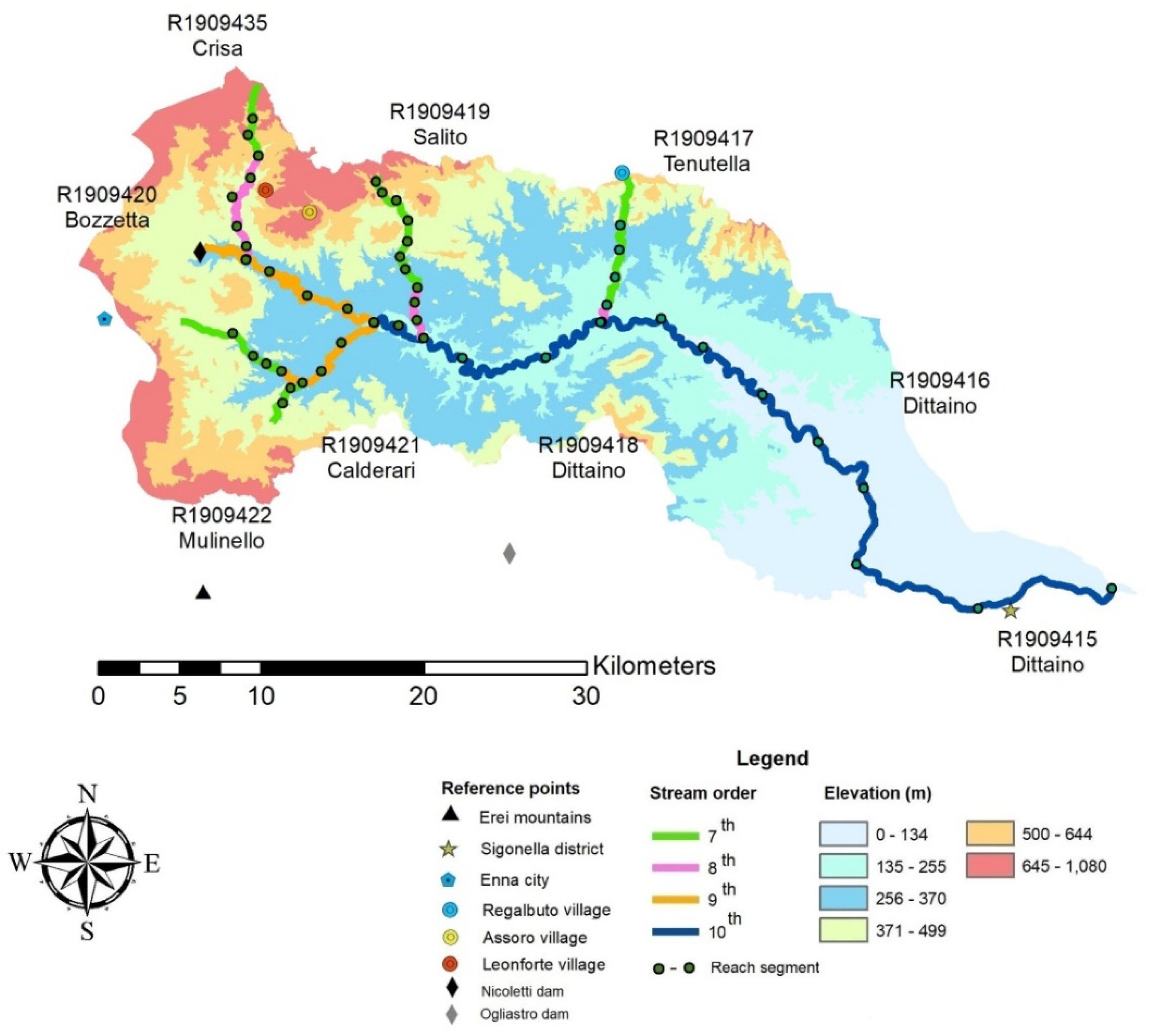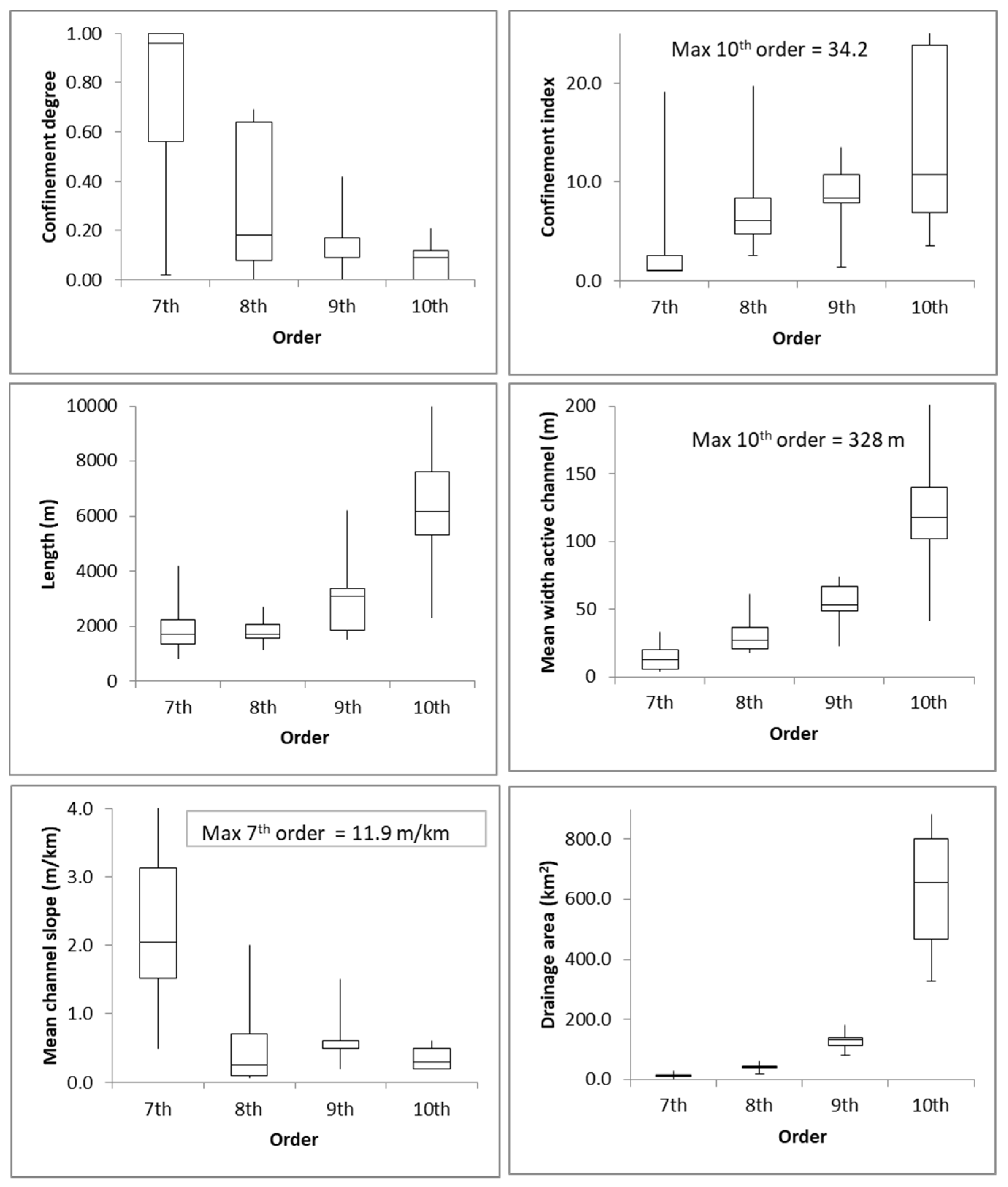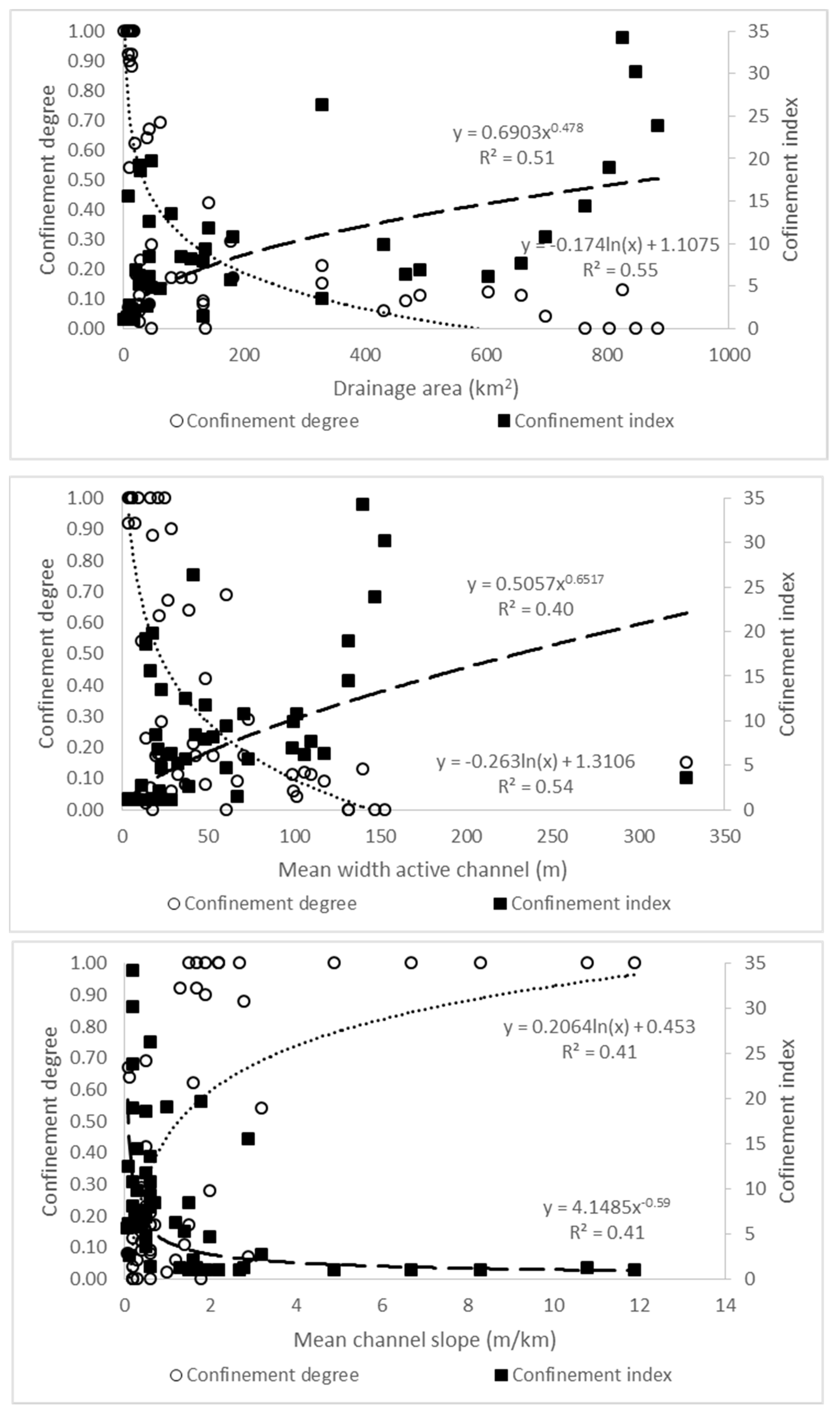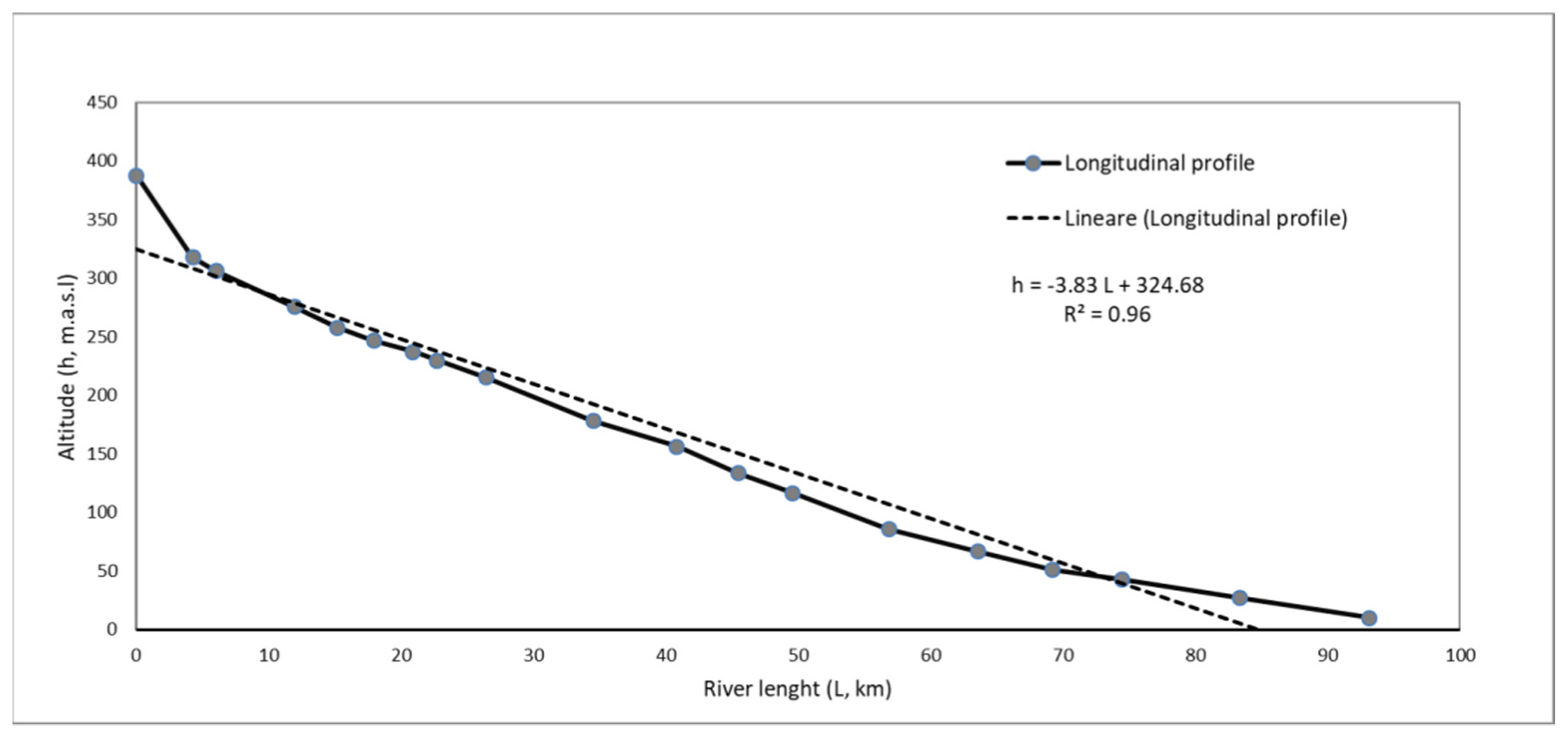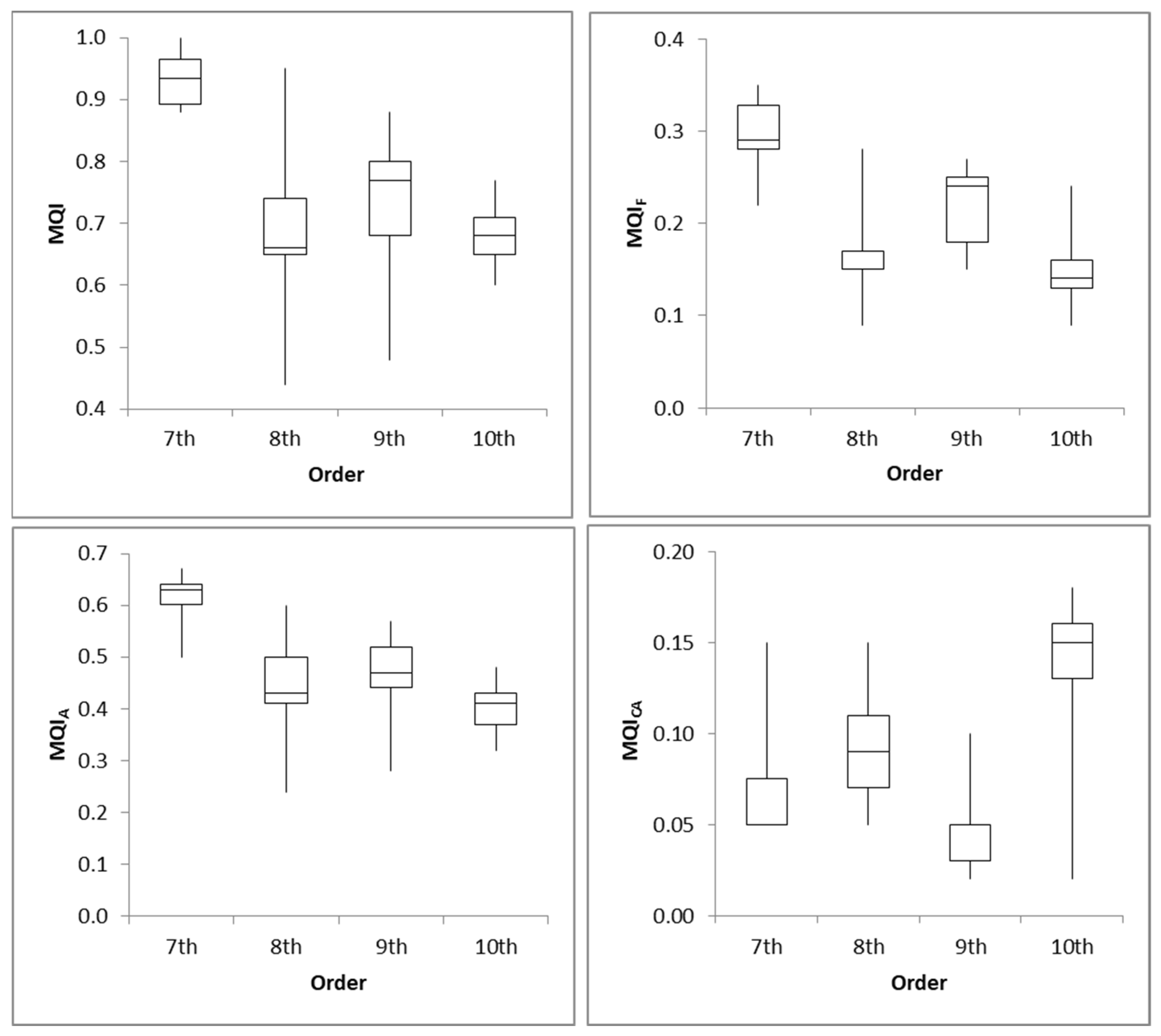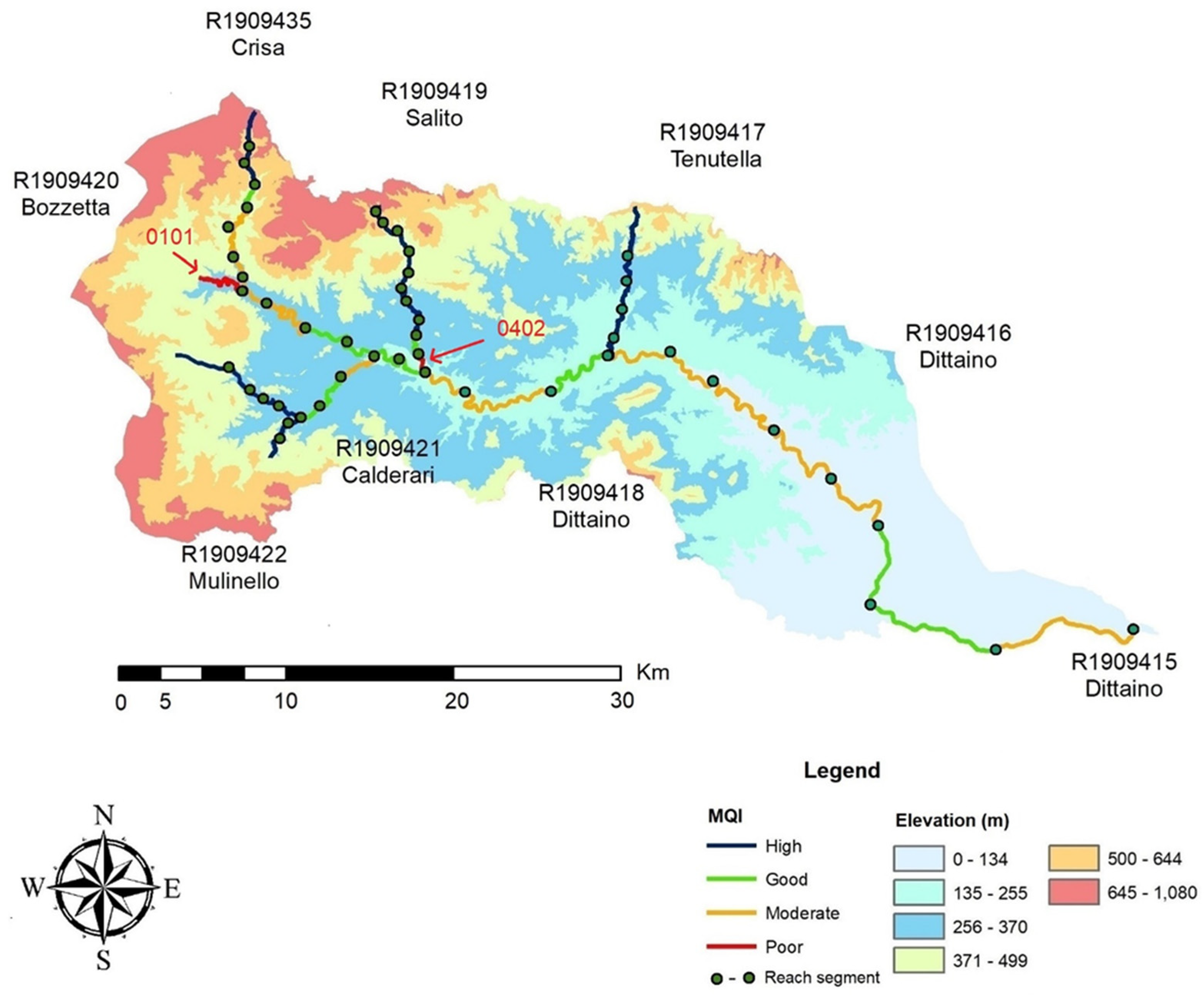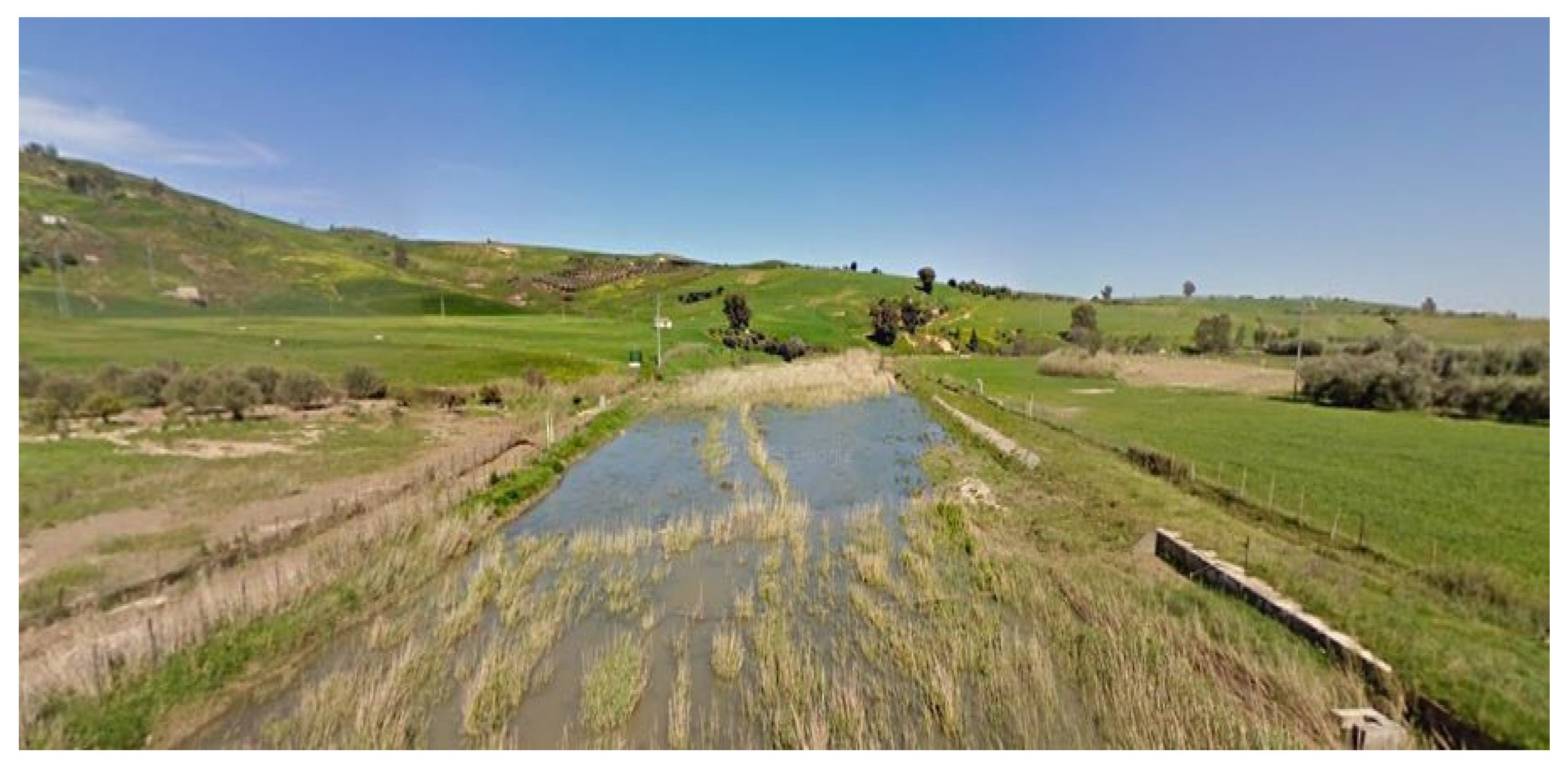1. Introduction
Rivers are dynamic natural systems that evolve in terms of their longitudinal and lateral sediment and morphological continuum through ongoing reworking processes [
1]. The resulting morphological changes can occur at the reach scale over short periods of time and limited spatial extents, or over long time intervals (from tens to thousands of years) and involve the entire river system [
2]. Moreover, the alterations may be of natural origin, or they may be anthropogenic [
3]. As a response to these alterations, the river adjusts its channel geometry in order to re-establish a dynamic equilibrium between sediment supply and available transport capacity by changing the characteristic channel variables [
4,
5].
Sediment production and delivery to the typically confined and steep drainage network prevail in the upper catchment [
6,
7,
8,
9,
10], while the large variability in terms of morphological configuration and bed roughness depends on confinement, the channel slope, and the specific boundary conditions. This variability is also reflected in the presence of bars and vegetated islands, which offer favorable conditions for the establishment of wetlands. Riparian wetlands can provide an important ecological function, including habitat provision for vegetation and other species, as well as regulation in the case of flooding [
11,
12].
In European countries, the integration of information on hydrology and fluvial geomorphology, called hydro-morphology, has been accelerated by the implementation of the EU Water Framework Directive WFD, ref. [
13]. Hydro-morphology requires an interface among different topics concerning the physical processes of river management actions and strategies [
14]. Since the establishment of the WFD, several methods have been adopted in European countries [
15,
16], which, in most cases, coincide with physical habitat assessment procedures [
17] and do not take into account physical processes [
18]. This may be because the methods are limited by the minimal understanding of physical processes and river alterations, related to the small scale of investigation, the limited use of geomorphological methods, and the use of a static temporal domain [
17]. Although some methods have been developed that make stronger considerations of physical processes at appropriate spatial and temporal scales, none are suitable for the Italian context [
17].
In general, methods that are not based on physical processes remain the most widely applied for assessing hydro-morphology [
19], given that morphology alone is not a sufficient field sampling methodology, and it requires integration with remote sensing (GIS) [
20].
In the last 200 years, most Italian and European rivers have suffered considerable human pressures at both the basin and channel scales, often involving river fragmentation [
21]. The phases of deforestation and reforestation, channelization, sediment mining, urbanization, dam building, torrent-control works, water diversion for agriculture and hydroelectric power generation, and many other interventions have modified natural water and sediment fluxes and boundary conditions [
22]. On the other hand, given the high level of urbanization, flood safety is a priority, as reported in the EU Flood Directive (WFD; [
23]).
Even though integrative approaches for river management with different objectives are desired by public agencies, EU directives often have conflicting objectives [
24]. This is specifically the case for the WFD and the FD, the former aiming to improve the ecological quality of water bodies, and the latter to identify measures to mitigate flood risk. Following this, the Italian National Institute for Environmental Protection and Research (ISPRA) developed a methodology for stream hydro-morphological evaluation, analysis, and monitoring, named IDRAIM (stream hydro-morphological evaluation, analysis, and monitoring system, [
24]). This procedure consists of an integrated analysis of morphological quality and channel dynamic hazards, aspiring to a harmonized implementation of both the WFD and FD directives. The IDRAIM framework is built on existing geomorphological approaches developed in other countries [
25], but it also accounts for the specific Italian context in terms of channel adjustments and human pressures and includes a component addressing fluvial dynamics. It is recognized that classification systems work best as guides to river management when developed for specific physiographic regions [
11].
The method, distinct from physical habitat assessment procedures, is characterized by a catchment-wide perspective, and the temporal component is explicitly accounted for in the analysis. Moreover, channel dynamics and the possible implications in terms of fluvial hazards are included in the analysis.
The structure of IDRAIM includes four phases [
24], as shown in
Figure 1. The characterization of the fluvial system (phase 1), based on a catchment-wide hierarchical framework, provides an initial characterization of the river system in its present conditions, and a segmentation into homogeneous reaches. Assessing the past evolution and present river conditions (phase 2) demands a reconstruction of evolutionary trajectories based on a series of key parameters (channel pattern and width and bed-level changes), as well as the assessment of present river conditions. These are investigated using the Morphological Quality Index (MQI), the Morphological Dynamic Index (MDI), as well as the Event Dynamic Classification (EDC) and the fluvial morphological dynamics corridors [
24]. The assessment of future trends (phase 3) considers potential future trajectories of the channel’s morphology in response to existing factors or to different management scenarios. The identification of management options (phase 4) focuses on the establishment of an integrative river management strategy that should take into account the results of the whole analysis.
The procedure has already been applied to some extend to several case studies. In particular, the MQI, aiming at an assessment, classification, and monitoring of the current morphological state, was tested on the Cordevole river in northeastern Italy [
26]. Since the index is the standard hydro-morphological assessment method for WFD classification and monitoring [
27], it was also applied to 102 river reaches representing a wide range of the physical conditions and human pressures that affect Italian streams. This application of the method enabled the testing of the overall methodology, the refinement of the indicators and scores, as well as the evaluation of limitations and strengths. The MQI was successfully applied to eight case studies across Europe to assess the hydro-morphological response to various restoration measures, as well as to evaluate the index as a morphological assessment method applied at the reach scale, combined with a conventional site-scale physical habitat assessment method. Despite the fact that these reaches were selected to represent a sufficiently wide range of conditions, most of them are localized in central and northern Italy [
17]. During the European FP7 project Restoring Rivers for Effective Catchment Management (REFORM), the MQI was extended and tested on a number of European streams [
28].
The MDI was applied in some Italian rivers for testing [
29] and, more recently, to modify the left embankment of the Secchia river (running through the Emilia-Romagna and Lombardia regions in Italy), so as to guarantee the bank’s stability and the hydraulic section’s suitability [
30].
Moreover, the hierarchical nested approach followed in IDRAIM was also used for the morphological characterization of the River Baker, located in Chilean Patagonia [
31].
In most cases, the IDRAIM procedure (or at least phase 1 and/or phase 2 thereof,
Figure 1) was tested and applied to rivers that had been characterized by their physical conditions (physiographic units, hydrological and climatic conditions) and morphological types, as well as by dynamic processes different from those observed in the Dittaino River and in the Mediterranean in general.
In this paper, the present conditions of the Dittaino River (Enna, eastern Sicily, Italy), one of the main tributaries of the Simeto River, are investigated via tools corresponding to different components of the IDRAIM procedure (morphological quality and dynamics). In particular, after the segmentation of the River, the MQI and the MDI are used to respectively analyze its morphological quality and classified the channel dynamics in relation to progressive changes occurring in the relative long-term (i.e., 50–100 years). The limitations, strengths, and the applicability of the procedure to the Dittaino River are also discussed.
2. Materials and Methods
2.1. Methodological Overview
Following the studies in [
17,
32,
33], phase 1 of the analysis was divided into four steps (
Table 1): the general setting and identification of the physiographic units and segments (step 1), the definition of the confinement typologies (step 2), the identification of morphological typologies (step 3), and reach delineation (step 4).
In the step 1, a basic investigation of geology, geomorphology, climate, and land use in the whole catchment was carried out. An initial segmentation (editing of lines) was then constructed based on physiographic units, hydrological discontinuities, significant geometric changes, and variations in geolithology. The subdivision was performed through the software Arc Hydro Tools (ArcGIS 10.3, ESRI
®) using orthophotos (flight ATA 708 of 2008), provided by the Sicily Region Department of Territory and Environment, the Digital Terrain Model (DTM) (format ASCII), Technical and Geolithological Maps of Sicily (both available on the Regional Geoportal), and the Map of Regional Physiographic Units (available on the website of the Italian National Institute for the Environmental Search and Protection, I.S.P.R.A.) [
34]. Slope and exposure maps were derived from the DTM. The Dittaino catchment was then divided into physiographic units and its fluvial system was divided into distinct segments, also taking into account the main confluences of its tributaries.
This geospatial information, together with the 2008 orthophotos, were used for photo-interpretation and active channel and alluvial plain editing. This editing was carried out across the river network from the seventh to the tenth order (following the Horton–Strahler classification; [
35]), based on the graphical representation scale.
In step 2, the river confinement was defined in detail, and the confinement degree and index were calculated using a semiautomatic procedure (based on a Geographic Information System). The confinement degree expresses the lateral confinement longitudinally, independently of the width of the alluvial plain. It corresponds to the percentage of banks in direct contact with the slopes (identified as terrain with a slope greater than 20°). The confinement index is defined as the ratio between alluvial plain width (including the channel) and channel width. Based on the confinement degree and index values [
32], a class of confinement (confined, C, partly confined, PC, and unconfined, UC) was assigned to each identified reach (
Table 2).
In the step 3 the channel morphology of the Dittaino River was analyzed in detail by calculating sinuosity, braiding, and anabranching indexes (calculated as in [
2]), and by considering the river typology (
Table 1), according to traditional classifications of river morphologies (e.g., [
6,
9,
36,
37]), but taking into account the specific Italian context (e.g., [
3,
38,
39]).
The PC and UC reaches are classified based on their planimetric pattern, and are divided into seven river morphologies (straight, sinuous, meandering, sinuous with alternate bars, wandering, braided, anastomosed). C reaches are classified at the first level based on their planform only, into single-thread, wandering, braided, and anastomosed [
33].
In step 4, additional discontinuities were considered to further subdivide the stream reaches, including hydrological discontinuities (e.g., tributaries, dams), bed slope (particularly for C reaches), and relevant changes in channel and alluvial plain width or bed sediment [
32]. The final product of this first phase was the subdivision of the Dittaino River network into relatively homogeneous reaches that represent elementary spatial units for the assessment of its morphological conditions.
In order to characterize the Dittaino’s watershed stage, regressions, including linear, exponential logarithmic, and power of the longitudinal river pattern profile, were established. The coefficient of determination (R
2) calculation determines the degree of fit. The curve with the highest R
2 value is the best curve. If the sediment is too coarse to be transported by the river, the longitudinal profile shows a low degree of concavity and hence a better linear function fit [
40]. If the transport capacity is saturated, as postulated by [
41], the channel sediment grain size will reduce downstream, and the longitudinal profile will be more suitable for the logarithmic function. With further increases in profile concavity, the power function becomes more appropriate. Thus, the temporal evolution sequence should be as follows: linear–exponential–logarithmic–power.
2.2. Morphological Quality Index
After the segmentation phase, the data and information needed to evaluate the MQI were acquired for each identified reach. Field surveys were carried out in the period July–December 2014. In total, 53 reaches of the Dittaino River’s network (37 in the upper part and 16 in the downstream area) were analyzed. As required by the IDRAIM procedure, the following three components of morphological analysis were considered: (i) geomorphological functionality, based on the comparison of forms and processes under the present conditions with those normally associated with that river typology; (ii) artificiality, based on the presence, frequency, and continuity of artificial structures and interventions; (iii) channel adjustments, addressing relatively recent morphological changes (i.e., about the last 100 years) indicating systemic instability related to human factors (with particular reference, as regards the planimetric changes, to the last 50–60 years). The evaluation of the 28 indicators was completed with the application of two types of MQI evaluation forms: (i) one for C channels and (ii) one for PC and UC channels (
Table 2) [
17]. Three classes were defined for each indicator. A score of 0 was assigned in the case of the absence or insignificant presence of alteration (answer A), 2 to 3 was assigned to the intermediate class of alteration (answer B), and 5 to 6 was assigned to the highest alteration class (answer C). When artificial elements are present at extreme densities and dominate the environment, additional points of alteration can be assigned. The final score was calculated as the ratio between the total alteration score (assigned to all indicators applied in the reach), S
tot, and the maximum possible total alteration score, S
max. As such, the Morphological Alteration Index (MAI) was defined as follows:
Therefore, the MAI ranges from 0 (no alteration) to 1 (maximum alteration). Given the index structure (considering various aspects and categories), it is possible to calculate a series of sub-indexes that divide the MAI into its components. This can be useful for identifying the negative and positive points of each reach. The sub-indexes of geomorphological functionality, artificiality, and channel adjustments, named the Functionality Morphological Alteration Index (MAI
F), the Artificiality Morphological Alteration Index (MAI
A), and the Channel Adjustment Morphological Alteration Index (MAI
CA), respectively, can be defined as follows:
where S
F tot = F
1 + … + F
13 (sum of scores of applied F indicators); S
A tot = A
1 + … + A
12 (sum of scores of applied A indicators); S
CA tot = CA
1 + … + CA
3 (sum of scores of applied CA indicators).
The Morphological Quality Index (MQI) is then defined as
Based on this formula, MQI describes the quality, defined as the relative absence of alteration, since MAI indicates the relative degree of alteration. The MQI index varies from 0 (minimum quality) to 1 (maximum quality).
Similar to MAI, MQI can be divided into the sub-indexes of functionality, artificiality, and channel adjustments, named the Functionality Morphological Quality Index (MQIF), the Artificiality Morphological Quality Index (MQIA), and the Channel Adjustment Morphological Quality Index (MQICA).
According to this structure, the reference conditions (i.e., class A for each indicator, corresponding to MQI = 1) are characterized by: (i) the full functionality of geomorphic processes along the reach; (ii) the absence or negligible presence of artificial elements along the reach and in the catchment (in terms of flow and sediment fluxes); and (iii) the absence of significant channel adjustments (configuration, width, bed elevation) over a temporal frame of about 100 years.
During the assessment and compilation of the evaluation forms, some indicators may be affected by a lack of data or information or may require a certain degree of subjective interpretation. To help in assessing how certain the user feels concerning their answer, a degree of confidence (low, medium, high) and a second (alternative) choice in the classes can be expressed. This is calculated by taking the scores associated with the second choice (with low or medium confidence in the answer) and obtaining a range of variability rather than a single final value of the MQI.
The three components (geomorphological functionality, artificiality, and channel adjustments) do not have the same weight in the final score of the MAI, and consequently in the MQI, with artificiality having the highest weight in the overall scoring, followed by functionality and channel adjustments. This is because past conditions are important, and may affect the morphological quality, but the artificial constraints and the functioning of processes in the present condition are the two major components of the evaluation. For example, considering C medium–big channels, the geomorphological functionality, artificiality, and channel adjustments have a maximum score of 37, 63, and 14, respectively (with a total score of 114); for C small channels, the adjustment is zero and the initial total score is equal to 100 (114–14). Then, considering PC and UC medium–big channels, the maximum scores are 46, 72, and 24, respectively (with a total score of 142); for small channels, the adjustment is zero, and the initial total score is equal to 118 (142–24).
Based on the MQI, five classes of morphological quality were defined (
Table 3).
2.3. Morphological Dynamic Index
The Morphological Dynamics Index (MDI) classifies the degree of channel dynamics related to progressive changes occurring over a relatively long time frame (i.e., 50–100 years), not including the possible responses to extreme flood events. The index is applied only to PC or UC reaches. MDI identifies reaches characterized by high riverbed dynamism [
2].
The structure is similar to the MQI and is based on a set of 11 indicators assessing the main factors controlling channel dynamics (e.g., river typology, bed and bank erodibility, past changes, and present trends of adjustment). The indicators are grouped into three main categories: morphology and processes, artificiality, and morphological changes (
Table 4). In particular, morphology and processes refer to general natural issues (such as the bed typology and material that constitutes the banks and bed), considering bank retreat processes as well as current. Artificiality indicators consider the obstacles that mostly influence morphological dynamic processes (such as transversal and longitudinal barriers). During the artificiality assessment, anthropic elements are considered, assessing their potential effects on dynamic processes (e.g., bank defenses as an impediment of bank retreat processes). Morphological change indicators refer to changes occurring in the last 50 years, related to various types of hazards, as well as instability conditions that can evolve during flood events.
Each indicator can be linked to the vertical dynamic (related to all aspects connected to the bed morphological dynamic) or the lateral dynamic (related to all aspects connected to the retreat of banks and width changes).
For each indicator, it is possible to provide different answers for classes (D-, C-, B-, A, B, C, D, E), and the score attributed to each indicator must be a whole number and not negative. The score is directly proportional to the dynamic degree—high scores refer to major morphological dynamics exhibiting naturalness as well as low artificial control. On the basis of the values of MDI, the classes of morphological dynamics with scores ranging from 0 to 1 are defined (
Table 5).
For the Dittaino River network, the MDI was evaluated for each PC/UC reach. The indicators of the categories of morphology and processes and artificiality were evaluated using maps and field survey analysis. The analysis of the indicators V1 (morphological configuration changes) and V2 (width changes), in particular, was carried out by comparing between remote sensing images (Orthophotos 2008) and maps of the flight IGM GAE of 1954/55, provided by the Military Geographical Institute (
Figure 2). The poor definition of the maps led to some difficulties during the interpretation of the results.
The MDI was evaluated for 37 reaches out of the total of 53 identified in the catchment during August–November 2015.
4. Discussion
Although the characterization of the current morphological condition of the Dittaino River is the first step towards a thorough comprehension of the functioning of the hydro-morphological system, it represents a necessary starting point, and can be taken as a basis to plan future investigations aiming at safeguarding natural resources and ensuring sustainable river management. Hydro-morphological assessment is increasingly being recognized as fundamental to classifying and monitoring the ecological status of streams, and to supporting the identification of possible and sustainable management actions. Hydro-morphological assessment needs to be process-based, and to provide an overall evaluation of river conditions (i.e., pressure and response).
During the fluvial characterization of the Dittaino River, the confinement degree of all reaches was found to be correlated negatively with the drainage area and the mean width of the active channel, while it was positively correlated with the mean channel slope. This behavior, already detected in other rivers [
31], could be related to tectonic and geologic legacy, and its effect on the geomorphological configuration of the reaches [
42]. In particular, the negative correlation of the confinement degree with both the drainage area and the mean width of the active channel can be explained by the fact that reaches located in the upper part of the basin (characterized by a small drainage area) generally display high slopes and high degrees of confinement degree. The confinement index displays the opposite behavior, due to the fact that it is inversely proportional to the confinement degree; the minimum value of 1 indicates that the floodplain and channel coincide (i.e., there is no floodplain), while the index increases when the floodplain’s width increases relative to the channel’s width [
29,
31].
Despite all this, 45% and 22% of the analyzed reaches (belonging mainly to the seventh and eighth orders) were, respectively, of high and good quality; the MQI class decreased to good, and then to moderate in the downstream direction, and two reaches were of a poor class. Based on the details of Italian rivers characterized by moderate and medium values of MQI and MDI, respectively, partial restoration could be achieved by removing bank protections and by converting the old interception structures into new constructions designed based on the criteria of river restoration engineering. The moderate values of MQI (equal to 0.54) calculated for the Ahr/Aurino River increased to 0.73 following a restoration project, including the removal of river bank protections [
20]. Reaches characterized by moderate values of MQI generally received greater restoration benefits compared with reaches of good or high quality [
43].
As also highlighted by other authors [
17], a series of limitations were identified during the application of the MQI method to the Dittaino River. First of all, some of the indicators were extremely simplified, and there was a strong degree of subjectivity in the scoring of the indexes, in relation to the experience and training of the operators. In general, the reaches with the greatest degree of morphological alteration showed: (i) poor connectivity between hill slopes and river corridor (mainly caused by the presence of roads), which is very important for the natural input of sediment; (ii) the absence of vegetation in the river corridor, which is intrinsic to a range of geomorphic processes, due to human alteration; and (iii) the presence of artificial elements, such as bed-load interception structures in the basin, bank protections along the reach, and the removal of sediment, wood, and vegetation, as already highlighted in [
26]. Moreover, MQI assessment necessitated the definition of numerous indicators, and sometimes the coded answers were not suitable for the hydrological and geomorphological conditions of the Dittaino River, given that most of the streams used in the testing phase of the procedure are localized in central and Northern Italy [
17], and some of the characteristics of rivers under Mediterranean weather conditions were not adequately considered. In the Mediterranean region, streams are characterized by irregular water flow and harsh hydrological fluctuations, the typical pattern involving floods in autumn–winter, and droughts developing gradually and continuously over the summer. Therefore, most rivers and streams, especially in the semi-arid regions of the southern Mediterranean, present a mixture of permanent flow (perennial) and natural intermittent flow (low flow that completely dries out in the summer) regimes. This can influence the development of macrophite communities, primarily by increasing the competition for space and resources, since habitats shrink, and the water quality deteriorates during low flow conditions [
44].
5. Conclusions
In this fluvial system (subdivided in 53 reaches), the mean values of length, width of the active channel, and the confinement index increased with the reach order, and the mean values of confinement degree and channel slope decreased with the reach order. The predominant morphological typologies were single-thread, sinuous, and meandering in the downstream direction. The predominant confinement typologies were C, PC, and UC in the downstream direction. The variability in confinement degree and mean channel slope was greater for reaches of a lower order, while the variability in confinement index, length, mean width of the active channel, and drainage area was greater for reaches of a higher order. That being said, 45% and 22% of the analyzed reaches (mainly belonging to the seventh and eighth orders) were, respectively, of high and good quality; the MQI class decreased to good, and then to moderate in the downstream direction, and two reaches were of a poor class. In particular, reach 402 of the Salito, immediately upstream of the confluence with the Bozzetta stream, was poor due to the continuous presence of bank protections and check-dams, and reach 101 of the Bozzetta stream was poor because of the Nicoletti dam, located just upstream. To assess the existing risks from a dynamic morphological perspective, the MDI was assessed for PC and UC reaches. The MDI class was high for 48% of the reaches, medium for 47%, and low for just 5% of the reaches. The highest MDI classes were primarily identified in the highest zones of the hydrographic network, where the MQI classes were between good and high. Again, reaches 402 of the Salito and 101 of the Bozzetta showed medium MDI values due to the presence of artificial control structures.
Some limitations and strengths were identified during the application of the MQI method to the Dittaino River. Both the high number of indicators required by the MQI procedure and the simplification of some mean that the method should be carried out by trained personnel with appropriate backgrounds and sufficient skills in fluvial geomorphology, GIS/remote sensing analysis, and field survey interpretation, in order to reduce bias and derive repeatable results. On the other hand, the simplification of some indicators makes the method easily applicable to a large number of reaches in a relatively short time. Moreover, the results were often unsuitable for the hydrological and geomorphological conditions of the Dittaino River. Moreover, the need to compare present conditions with those of the past necessitated the use of poorly defined historical IGM maps from 1954, producing some difficulties in the interpretation of results.
Although, in general, the IDRAIM procedure does not seem to be able to provide precise design indications that can improve the dynamic morphological conditions of the river, it constitutes a suitable tool for assessing the present geomorphological conditions of a given stream reach (by MQI class), and specifically, the deviation of such conditions from a given point. It also supports the assessment of the dynamic morphological risk (by MDI classes). The application of the IDRAIM procedure to the whole hydrological network of large basins can help prioritize necessary areas of intervention.
Moreover, the novelty of using the IDRAIM procedure to combine the WFD and FD directives is plain, achieved through an integrated analysis of morphological quality and channel dynamic hazards specific to the Italian context.
This is very important because the assessment of a river’s ecological status, including its hydro-morphological and morphological dynamics, which can be used for the implementation of design models and interventions integrating protection and environmental requalification, requires the evaluation of hydro-morphological state changes. As such, the IDRAIM procedure could help in sustainable river management.
